
An N11 code is a three-digit dialing code used in abbreviated dialing in the North American Numbering Plan (NANP). The mnemonic N stands for the digits 2 through 9 and thus the syntax stands for the codes 211, 311, 411, 511, 611, 711, 811, and 911. These dialing codes provide access to special local services, such a 911 for emergency services, which is a facility mandated by law in the United States.
A crisis hotline is a phone number people can call to get immediate emergency telephone counseling, usually by trained volunteers. The first such service was founded in England in 1951 and such hotlines have existed in most major cities of the English speaking world at least since the mid-1970s. Initially set up to help those contemplating suicide, many have expanded their mandate to deal more generally with emotional crises. Similar hotlines operate to help people in other circumstances, including rape, bullying, self-harm, runaway children, human trafficking, and people who identify as LGBT or intersex. Despite crisis hotlines being common, their effectiveness in reducing suicides is not clear.
Ten-digit dialing is a telephone dialing procedure in the countries and territories that are members of the North American Numbering Plan (NANP). It is the practice of including the area code of a telephone number when dialing to initiate a telephone call. When necessary, the ten-digit number may be prefixed with the trunk code 1, which is referred to as 1+10-digit dialing or national format.
Seven-digit dialing is a telephone dialing procedure customary in some territories of the North American Numbering Plan (NANP) for dialing telephone numbers in the same numbering plan area (NPA). NANP telephone numbers consist of ten digits, of which the leading three are the area code. In seven-digit dialing it is not necessary to dial the area code. The procedure is also sometimes known as local format or network format.
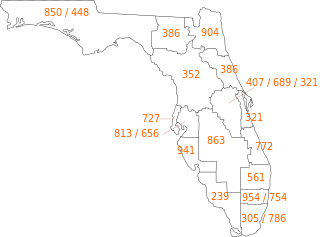
Area codes 561 and 728 are telephone area codes in the North American Numbering Plan (NANP) for Palm Beach County in the U.S. state of Florida. 561 was created on May 13, 1996, in a split of area code 407. The numbering plan area (NPA) comprises nearly every major city in the county, the largest of which being West Palm Beach, Boca Raton, Wellington, Boynton Beach, Jupiter, Delray Beach, and Belle Glade. On March 10, 2023, area code 728 was added to the same numbering plan area to form an all-services distributed overlay.
Abbreviated dialing is the use of a very short digit sequence to reach specific telephone numbers, such as those of public services. The purpose of such numbers is to be universal, short, and easy to remember. Typically they are two or three digits.
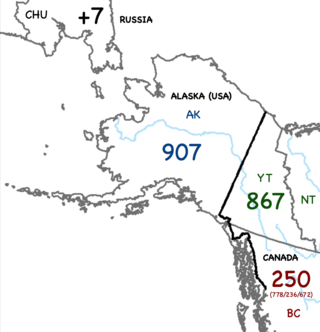
Area code 907 is a telephone area code in the North American Numbering Plan (NANP) for the U.S. state of Alaska, except for the small southeastern community of Hyder, which uses area codes 236, 250, and 778 of neighboring Stewart, British Columbia.

Area codes 608 and 353 are telephone area codes in the North American Numbering Plan for much of southwestern Wisconsin, including the state capital city Madison. Area code 608 was assigned in 1955 to a numbering plan area created from areas with area code 414 and area code 715, and was the third area code created in Wisconsin. Rapid growth of the area, specifically in Dane County, brought the area code close to exhaustion of central office prefixes, with NANPA projections in 2022 projecting the need for relief by late 2023. In September 2022, the Wisconsin Public Service Commission and North American Numbering Plan Administrator (NANPA) announced an overlay complex for the numbering plan area with new area code 353, with an in-service date of September 15, 2023. New central office code orders were accepted starting on July 11, 2023, but activatlon is contingent on complete exhaustion of central office codes for 608.
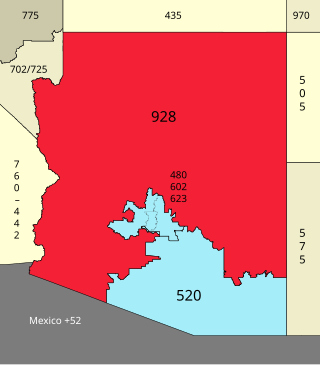
Area code 928 is a telephone area code in the North American Numbering Plan for the U.S. state of Arizona. The numbering plan area comprises the northern, eastern, and western portions of the state. It includes Beaver Dam, the Grand Canyon, Flagstaff, Holbrook, Lake Havasu City, Littlefield, Kingman, Prescott, Sedona, Wickenburg, Winslow and Yuma, and also serves most of Greenlee County, some areas on the western and northern fringes of the Phoenix metropolitan area, such as Lake Pleasant Regional Park in Peoria, and the Arizona portion of the Navajo Nation.

Area code 276 is a telephone area code in the North American Numbering Plan (NANP) for the western part of the U.S. state of Virginia. It was established by a split of area code 540 on September 1, 2001.
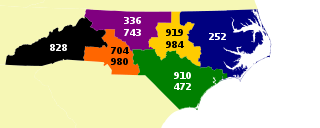
Area codes 910 and 472 are telephone area codes in the North American Numbering Plan (NANP) for southeastern North Carolina. The area codes form an overlay for a numbering plan area (NPA) that includes the cities of Wilmington, Jacksonville, Laurinburg, Lumberton and Fayetteville. Area code 910 was established in 1993, and 472 was added to the same area in October 2022.

Area code 302 is a telephone area code in the North American Numbering Plan (NANP) for the U.S. state of Delaware. It is Delaware's only area code, and was assigned in 1947 as one of the original North American area codes.

Area code 906 is the telephone area code in the North American Numbering Plan (NANP) for the Upper Peninsula of Michigan.

Area code 509 is the telephone area code in the North American Numbering Plan (NANP) for the eastern part of the U.S. state of Washington. The numbering plan area (NPA) roughly comprises the state east of the Cascade Mountains, and includes Spokane, the Tri-Cities, Ellensburg, Yakima, Walla Walla, and Wenatchee. The area code was assigned in a split of area code 206 in 1956.
Area code 254 is a telephone area code in the North American Numbering Plan for the Waco/Temple/Killeen area in the U.S. state of Texas. It was created May 25, 1997, in an area code split of area code 817.

Area code 319 is a telephone area code in the North American Numbering Plan (NANP) for the southeastern and east-central parts of the U.S. state of Iowa.

Area codes 618 and 730 are telephone area codes in the North American Numbering Plan (NANP) for southern Illinois. The numbering plan area (NPA) comprises one hundred and twenty-six municipalities, such as Carbondale, Cairo, Belleville, East St. Louis, Edwardsville, Marion, O'Fallon, Alton, Mt. Vernon, Centralia, Herrin, Salem, Metropolis, Fairview Heights, Collinsville, and Granite City. Area code 618 was one of the original North American area codes created in 1947, and 730 was added to the plan area to form an overlay complex to satisfy the need for more telephone numbers in the region. The current population of the 618/730 area code is 1,288,816 people. It encompasses approximately 15,458 square mile ; and has a population density of 83.38 people per square mile.
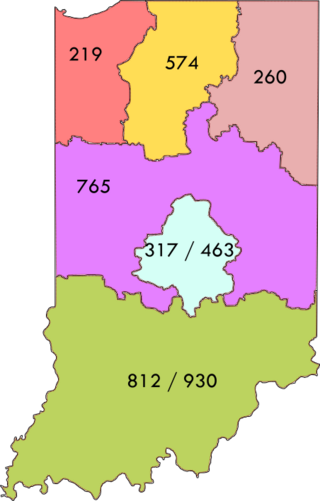
Area code 574 is a telephone area code in the North American Numbering Plan (NANP) for the northern part of the U.S. state of Indiana. It was created in a three-way area code split from area code 219 in 2002.
Area code 731 is a telephone area code in the North American Numbering Plan (NANP) for the western part of the U.S. state of Tennessee.
The area code 671 is the local telephone area code of the United States territory of Guam. It was created with the beginning of permissive dialing on July 1, 1997, replacing Guam's previous International Telecommunication Union country code 671 at the end of permissive dialing on July 1, 1998.














